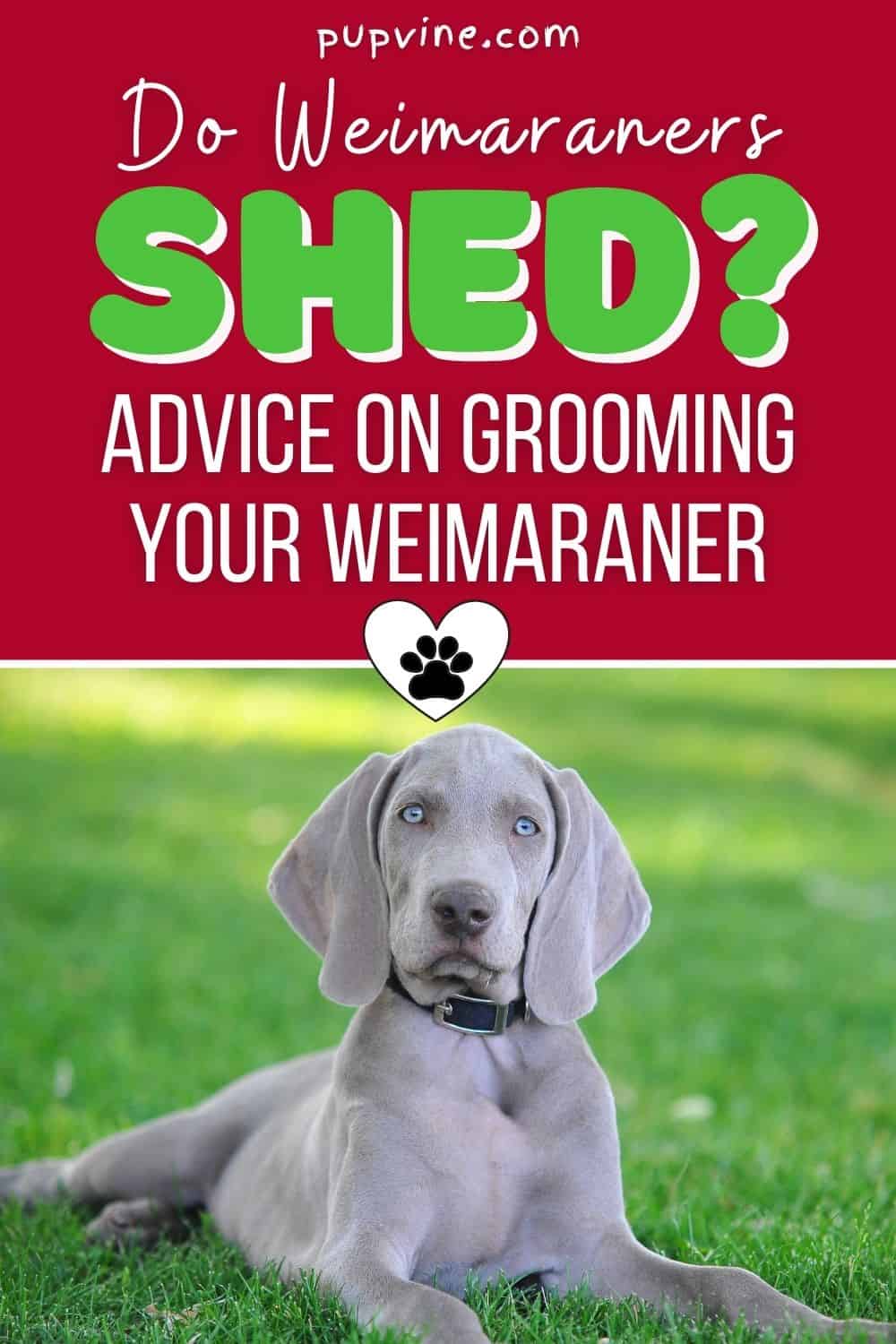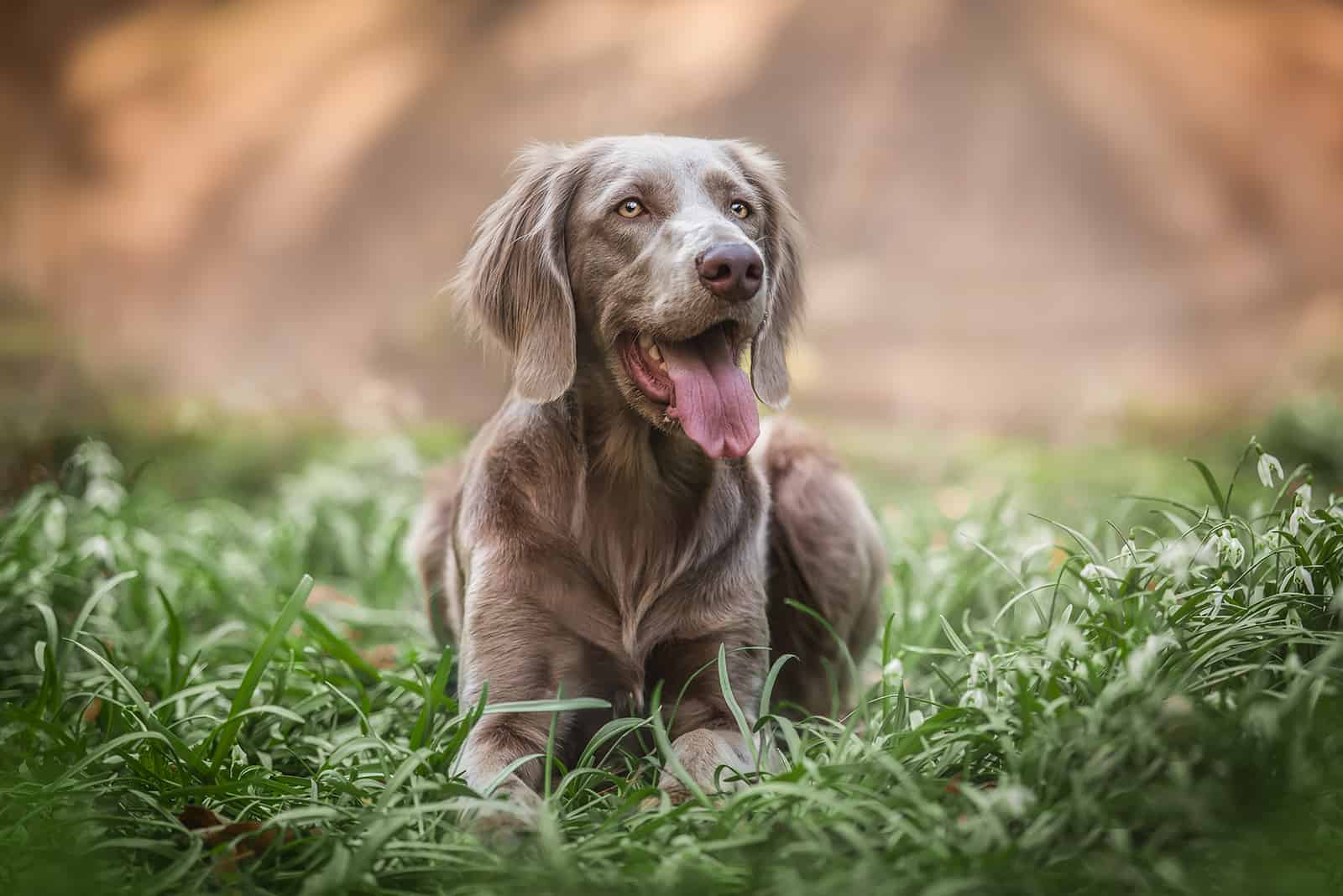Let’s get this straight before we begin: all dogs shed! Although coats differ from breed to breed, every dog will shed hair to some extent. It’s just that some are better or worse than others. It might be better to ask the following question…
Do Weimaraners Shed A Lot?
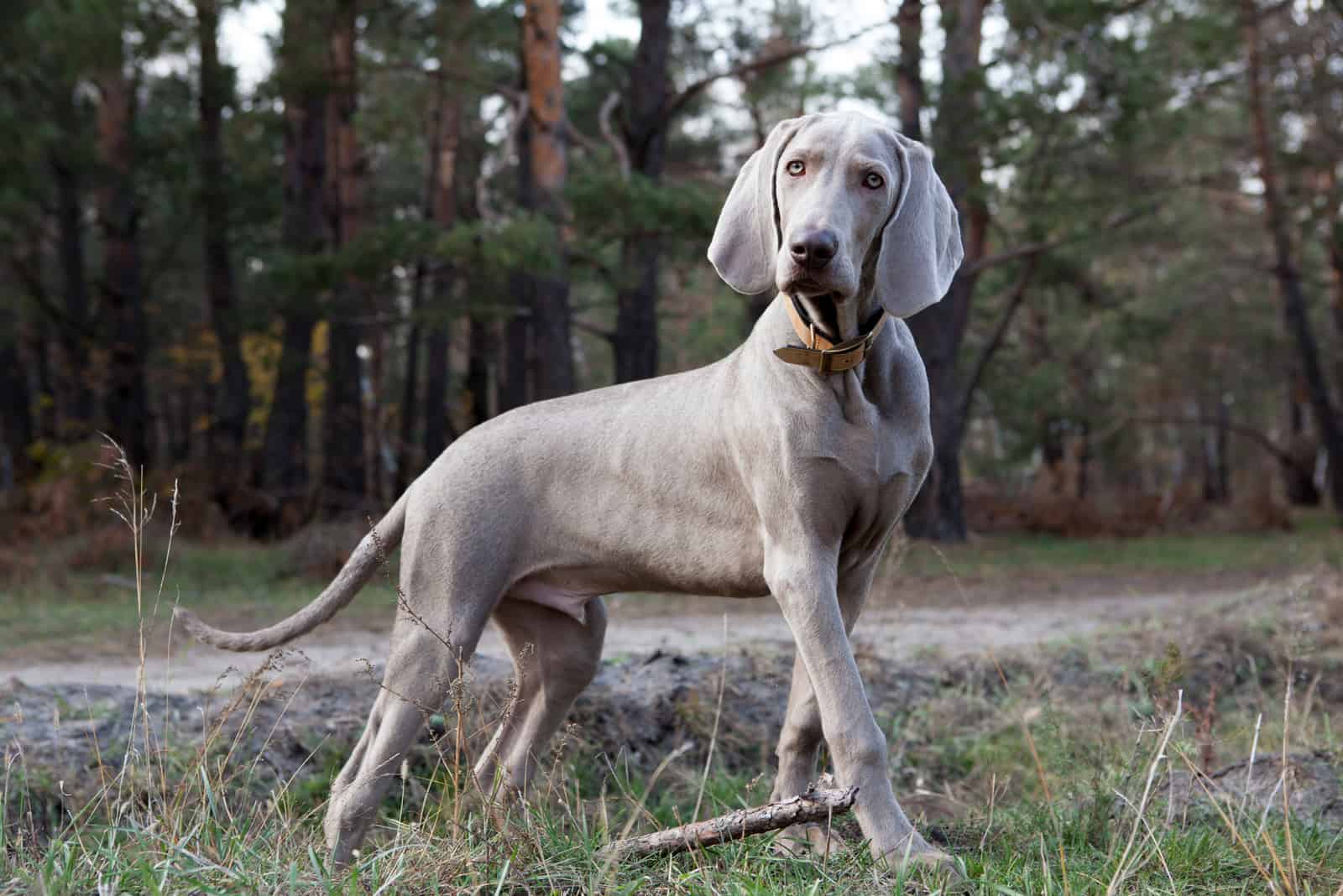
The answer may surprise you, as there’s a common misconception that, being mostly short-haired, they don’t shed much, if at all. However, this breed is seen as a ‘moderate-to-heavy shedder’! We’ll take a look at why this a little further on, along with some other helpful information about this beautiful-looking dog.
Before we do this, let’s begin by looking at why people might be asking these questions.
Most dog owners will be fine with a bit of dog hair about the place. Obviously, you don’t want masses of the stuff caked on your clothes and furniture or clogging your vacuum cleaner. And then there’s the grooming, which can be a real chore with some long-haired dogs.
Aside from this, there’s the question of allergens. For those suffering from allergies, dog hair can cause a great deal of distress. Because of the misconception about short-haired dog breeds being better for allergy sufferers, it is possible that someone may unwittingly get a dog that will trigger their allergy! However, many short-haired breeds, such as French Bulldogs, Corgis, Dobermans, and Dachshunds, are nowhere near hypoallergenic.
It’s extremely important that you find a dog that suits your circumstances, for you and for the dog involved.
To help you discover this, we’ll investigate the issue of shedding, as well as take a look at other aspects of owning a Weimaraner.
Are Weimaraners Low Shedding?
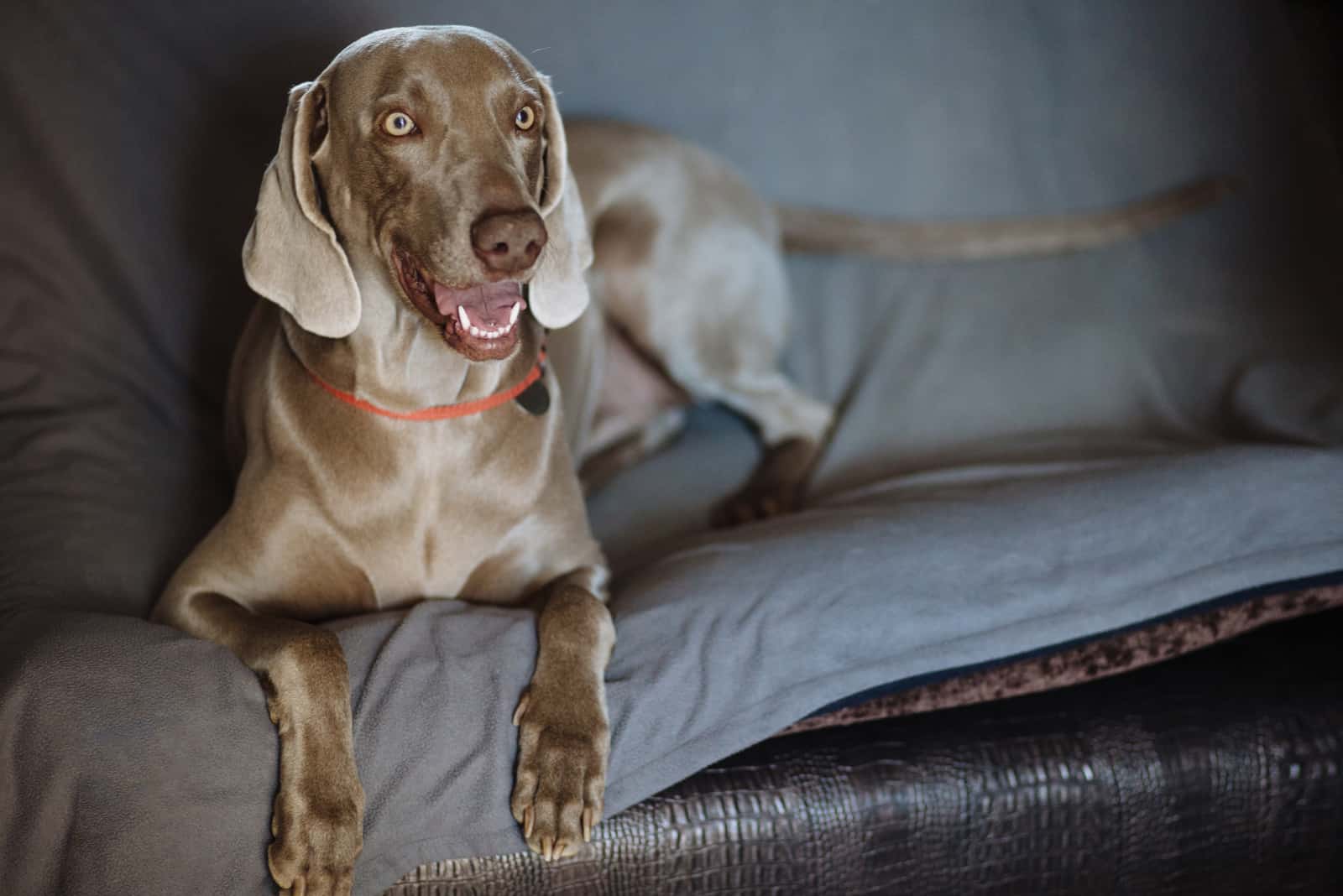
It’s another way of asking the same question above, and the answer is probably not! But it helps us to explain in more detail. You see, there are two different types of Weimaraner coats: long-haired and short-haired. This could prompt people to wonder whether there’s a difference in the amount that each one sheds.
To answer this in full, we need to understand why dogs shed at all, as well as the factors that can affect the timing and amount of hair shed.
Dogs are generally either single-coated or double-coated. The double-coat has coarse hairs on top, with a thick layer of fur beneath. It is this fur undercoat that drops in spring and fall, attaching itself to everything in sight! The dead hair has to be brushed out to avoid matting, which is painful and can cause skin infections.
Single-coated dogs only have a top layer of hair and tend to shed less, or at least give the appearance of doing so as they are easier to groom.
As mentioned earlier, many dogs will molt noticeably more during spring and fall. Still, the amount of shedding has more to do with the lengthening or shortening of the daylight hours rather than the length of the coat and temperature. Each dog will differ, too, with some dogs shedding more than others. All dogs will shed all year round to some extent.
Weims, as they’re known, will shed seasonally, whether long or short-haired. It might look as if the longer hair is more apparent than the short hair, but that is likely due to the size of the hairs; although they shed the same amount, you just notice long hairs more!
Are Weimaraners Hypoallergenic?
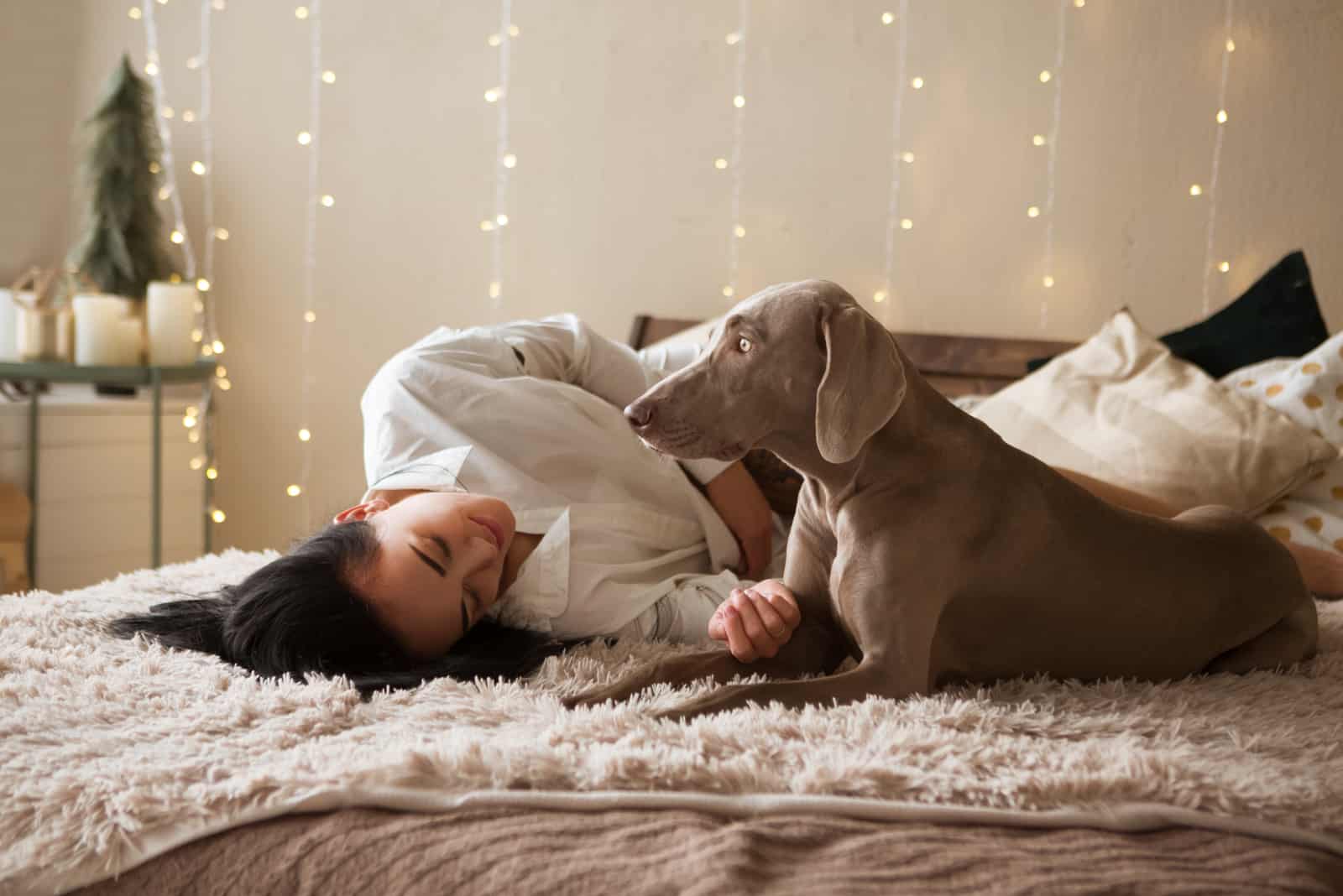
In short, no. Although the amount of hair that falls and sticks to soft furnishings and clothes can be kept under control through grooming, the truth is more complicated.
As more studies are undertaken into the subject, the results seem to be showing that there isn’t much difference between breeds when it comes to producing allergens.
The problem is, most people misunderstand the term hypoallergenic. There has been a tendency to accept this word as meaning that the dog will not trigger an allergic reaction. In fact, it means that you are less likely to have an allergic reaction.
Another commonly held belief is that the hair itself triggers an allergic reaction when in reality, it is the dander (dry flakes of skin) and proteins in the dog’s saliva that people are allergic to.
Breeds that are regarded as being hypoallergenic (such as the Poodle, Shih Tzu, and Havanese) tend to be those who don’t produce as much oil in their skin and are not prone to licking their coats as much to clean them.
German Hunting Dogs As Pets?

There’s something about the Weimaraner that sets it apart from other dog breeds. Perhaps it’s the athletic, regal appearance, or its distinctive, piercing light blue or amber eyes. Maybe it’s the alertness and intelligence in those eyes or that beautiful, silver coat with its glossy sheen that has earned it the name, the gray ghost.
Weimaraner dogs were first bred in the early 19th century, named for the Grand Duke of Saxe-Weimar-Eisenach, Karl August, who happened to hold court in the city of Weimer.
At the time, hunting big game, such as deer, boar, bears, and even mountain lions, was a popular pastime. These dogs were perfect for the task, earning a reputation for being fearless and obedient.
As the fashion for hunting large game declined, this breed became accustomed to hunting smaller creatures, such as rabbits, foxes, and game birds. They are now more likely to be used as a retriever, fetching game at a shoot.
There is some doubt as to the breeds used to create Weims, although it is suggested that they are related to the St. Hubert Hound, from which we also get Bloodhounds.
The American Kennel Club still classes them as a sporting dog, while the UK Kennel Club lists them as a gun dog. However, many people don’t buy them as working dogs these days and prefer to keep them as family pets.
The AKC sets the breed standards for Weims, stating that they should have a short coat and docked tail. Elsewhere, this rule is relaxed as the docking of tails is now illegal, except in certain circumstances, and in places like England and Germany, the long coat is acceptable.
The coat color is usually silver-gray but can also be mouse-gray.
Do They Have Health Problems?
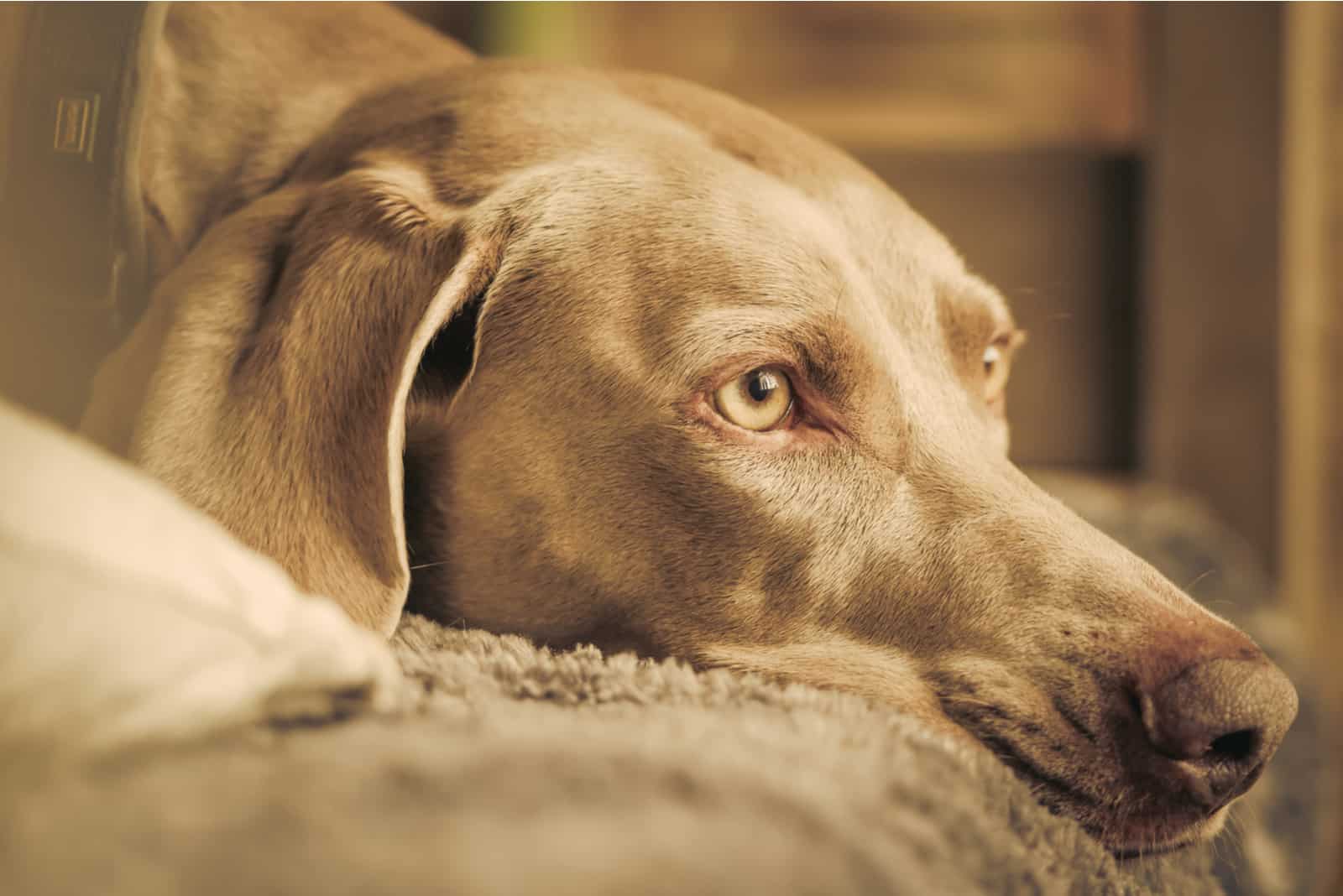
• Hip dysplasia – this condition is caused by a poorly-fitting ball and socket joint that makes the bones grind against each other. This is a usual condition in small dog breeds, such as Shiba Inus and Jack Russels. Arthritis is a common result in later life. Weims are also vulnerable to elbow dysplasia and patellar luxation to a lesser extent.
• GDV – Gastric dilatation-volvulus (known as bloat) is a potentially fatal condition where gas fills the stomach, which then twists, cutting off the blood supply to internal organs. The exact cause is unknown, although rapid eating, overeating/drinking (especially before exercise), and stress have been cited as factors. Great Danes are especially prone to this.
• Distichiasis – a painful condition where the small eyelashes turn inwards and scrape against the eyeball.
• Cancer – fibrosarcoma and mastocytoma are two leading causes of death in Weimaraner dogs.
• Hypothyroidism – an underactive thyroid gland does not produce all the hormones needed for the dog to function properly. Symptoms include weight gain, lethargy, and changes to the skin and hair.
• Heart disease – tricuspid valve dysplasia in Weims has become a cause for concern in more recent years.
• Von Willebrand’s disease – a blood disorder that stops platelets from forming. This means that the blood will not be able to clot properly in the event of injury or during surgery.
These are a few of the common health issues that can affect Weims, although they are generally considered a healthy breed. They have a lifespan of between 10 and 13 years, which can be extended by feeding them high-quality dog food, only using respected, reputable breeders, and by having regular trips to the vet.
Do They Need Much Grooming?
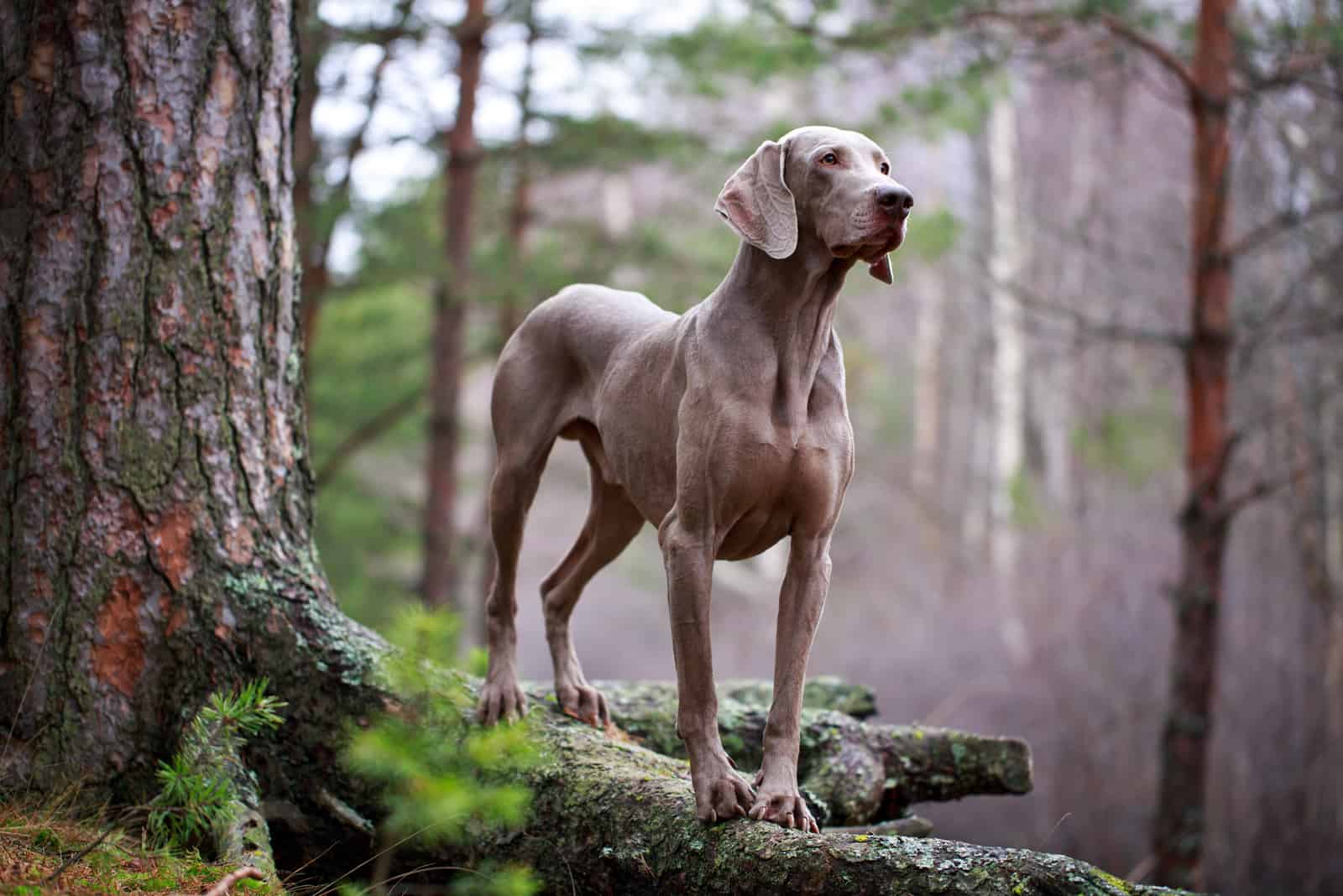
Although short-haired Weimaraners do shed quite a lot, they don’t take a lot of grooming. Long-haired Weimaraners take a bit more effort to get rid of all that loose hair.
Weekly brushing is recommended for the short-haired dog, using a soft bristle brush, grooming tool, or a curry brush. This will rid the coat of dead hair and reduce the chances of you having to use a lint roller.
This shorter coat, while being easier to maintain, makes them sensitive to weather extremes. They won’t fare so well in the cold, unlike similar breeds such as the German Shorthaired Pointer.
The main thing when it comes to grooming is their toenails. These need to be clipped regularly as they can grow too long and cause severe problems.
Related: How To Sedate A Dog For Nail Clipping – We Are Here To Help You
Those floppy ears will need checking and cleaning to avoid infections, and their teeth will need brushing to encourage good oral hygiene.
Are Weimaraners Good Family Dogs?
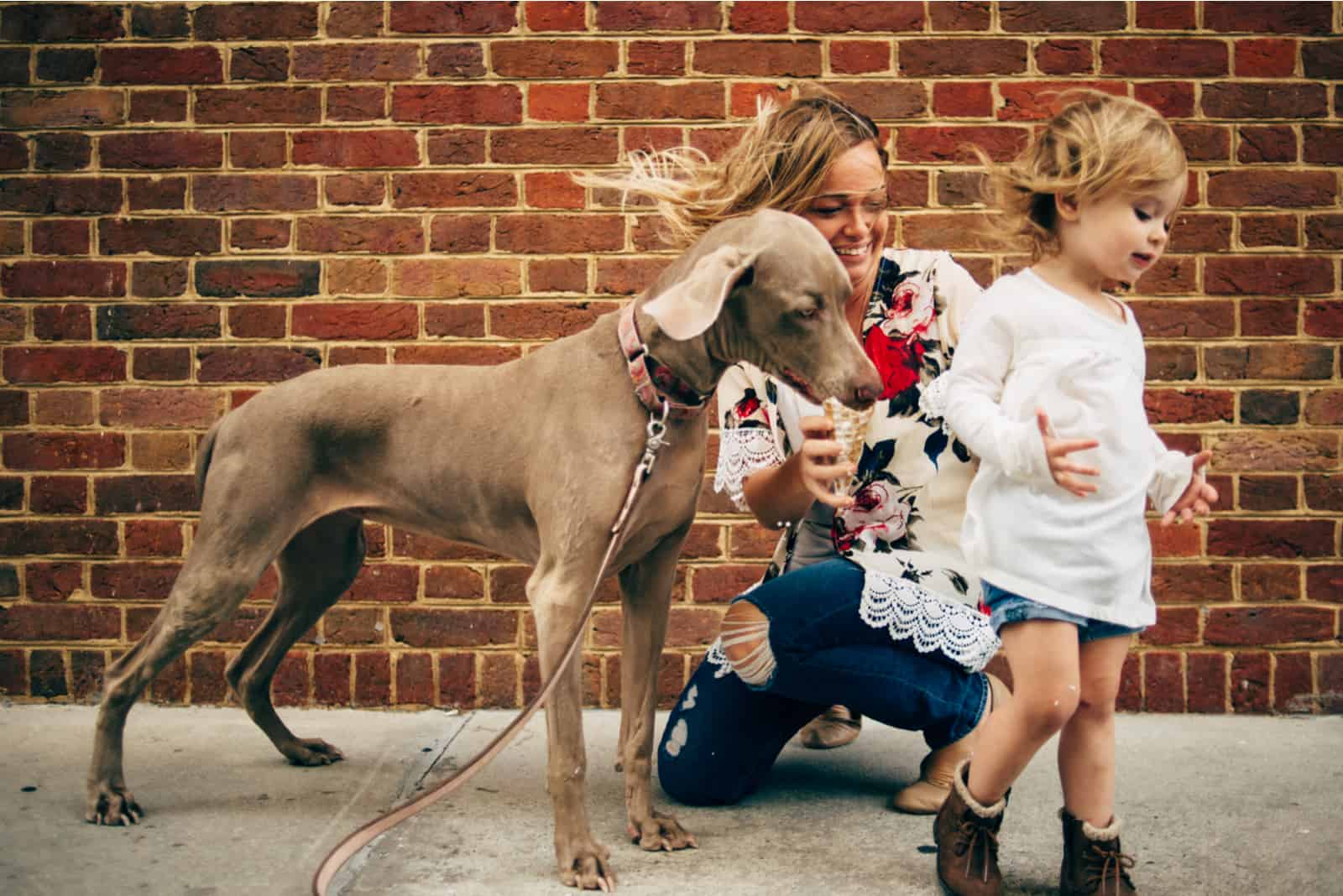
These are seriously energetic and active dogs that need a lot of time outdoors. They are perfect for adventurous families who love outdoor pursuits. Don’t think that they’ll be satisfied with a gentle walk in the park. These large dogs* will enjoy a good long run every day to use up all that energy. Forty minutes of exercise a day is the absolute minimum.
*While there is a slight difference in size between genders, both are big dogs. Males average 66cm (26ins) at the withers, and females average 61cm (24ins) in height.
A large yard is a must for these pooches, but make sure it has a strong, high fence, or your curious pup will be out roaming the neighborhood!
Because of their boundless energy and size, they aren’t perhaps the best choice as a first-time family pet. Also, you need to take care if you have kids under the age of six. It isn’t that they won’t get on; it’s more that these dogs are lively and boisterous. They will tolerate a good deal of teasing and tugging, but there is a chance that they will retaliate when they’ve had enough.

Photo from @thescoobylife
This breed won’t generally interact well with other family pets, especially small animals such as rabbits, cats, hamsters, etc. Their hunting instinct is very strong, which means that there’s a good chance they will attack and kill these creatures.
They will also happily drop a dead bird, cat, or frog at your feet and wait expectantly for praise. This is a present, and they will look to you for a reward. Punishing them for doing this is a mistake, as it could confuse them and damage the bond between you.
Weimaraners are highly intelligent and require a lot of mental stimulation. Without this, they tend to bark and become extremely destructive. Boredom and separation anxiety could cost you a fortune in home decor, repairs, and any items they vent their feelings on – all of which can increase the cost of having a Weimaraner!
If you’re looking for a watchdog, then this could be the breed for you. They are alert, protective, and vocal. Though not generally aggressive, they are intolerant towards dogs of the same sex and will let them know about it!
You might even look at some of the Weimaraner crossbreeds, such as the Pitbull mix that is becoming increasingly popular.
The Main Facts
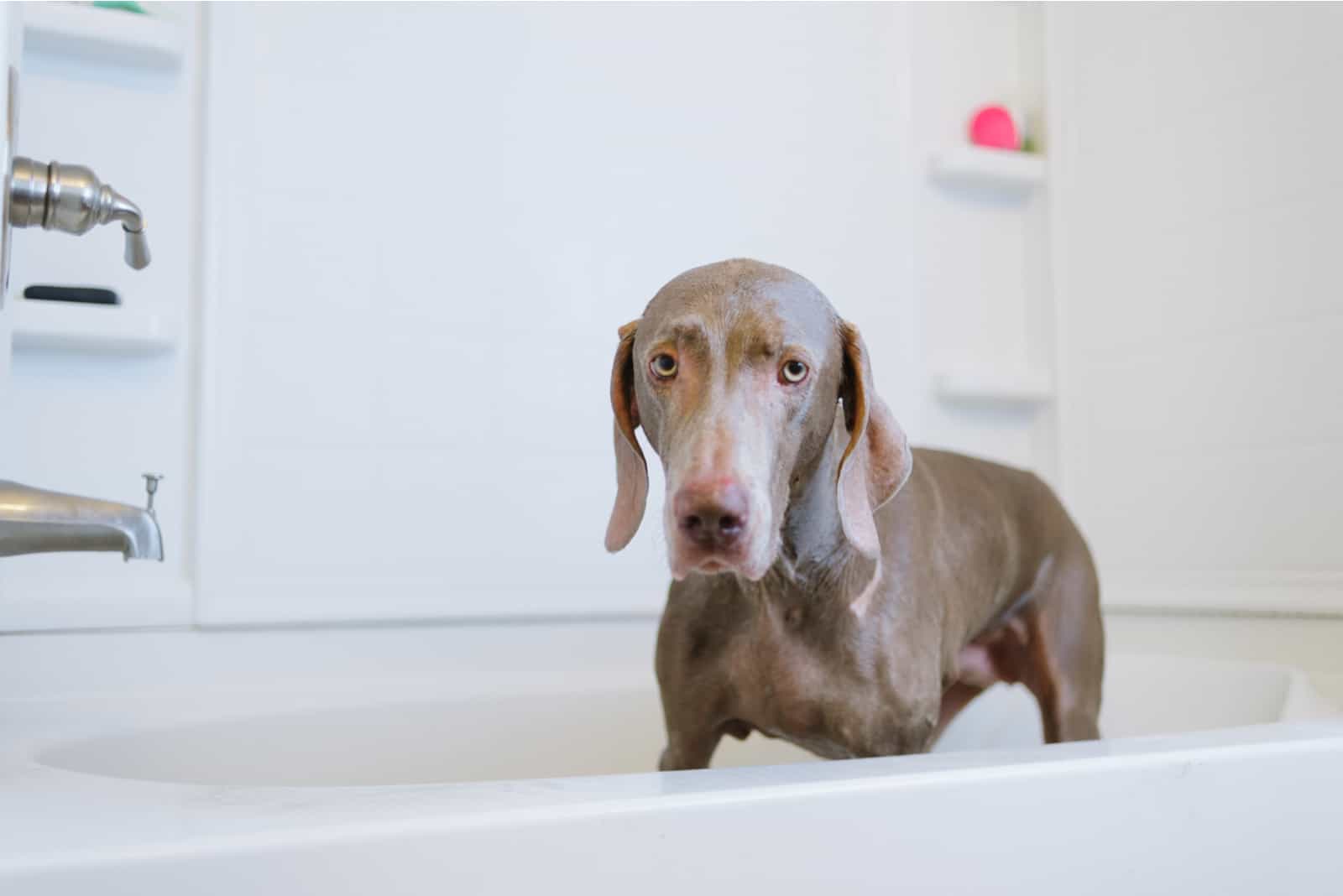
So, the Weimaraner is a sleek, toned athlete that needs exercise. Short-haired or long, it will require regular brushing, but the former will take less of your time. To keep the shedding under control, even more, feed them good quality food and bathe them fairly regularly using a special shampoo for dogs.
They aren’t regarded as being hypoallergenic, although this term is being questioned these days. However, they are not recommended for anyone with severe allergies.
Weims will make great family pets, but it has to be the right family! Ideally, you won’t have small pets in the home as they could be at risk. The hunting instinct can be partly overcome through training and socialization, and this can also improve their behavior when it comes to interacting with other dogs and children.
These dogs are better suited to families with teenagers or children over six years old, as they tend to be energetic, boisterous, and proud.
You will have to be active, taking the dog out for a long run so they can let off steam. Even when they’re at home, they’ll need plenty of room to run around. You’ll need to keep them occupied and entertained, as boredom will get them digging holes in your yard and chewing up everything in sight.
In the end, it’s never a good idea to choose a dog based just on its coat. These are stunningly beautiful animals that require a firm hand and the right conditions in which to thrive.
If you’re a ‘first timer’ when it comes to owning a dog, then perhaps this isn’t the dog for you. If you want to have a better idea of what’s in store, try seeking out an older dog from a shelter – it will already be displaying its adult character traits, will probably have had some training, and will be more settled.
On the other hand, if you’re the adventurous type, with an active, outdoor lifestyle and plenty of energy (as well as a big yard!) and you’re prepared to put in the hours, then you could do worse than getting yourself one of those adorable Weimaraner puppies.
Read Next: 6 Weimaraner Breeders In Ontario That You Need To Know About
